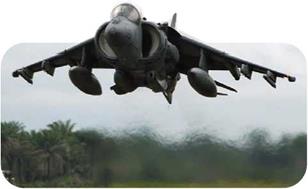Jet Planes
Some jet planes are able to take off and land vertically by swiveling their engine nozzles downward. This is called vectored thrust. Fighter planes increasingly use vectored thrust for steering. VTOL aircraft use it to generate lift. The Harrier Jump Jet uses this method.
|
О A Harrier Jump Jet uses vectored thrust to generate lift and take off. |
The jet of gas from the Harrier’s engine comes out through four nozzles instead of just one. There are two nozzles at the front of the aircraft and two more at the back. The pilot can rotate all of the nozzles together by moving one control in the cockpit. The nozzles are pointed downward for vertical takeoff, landing, and hovering, and turned backward for normal forward flight. They even can swivel forward a little, so the Harrier can fly backward.
When a jet plane is taking off vertically, hovering, or flying slowly, air does not flow around it fast enough for its control surfaces (the rudder, elevators, and ailerons) to work. The plane has to control its attitude, or position in relation to the horizon, in a different way. A small amount of air from the engine is piped to small nozzles in the aircraft’s nose, tail, and wingtips. Blowing air out of these nozzles can turn the aircraft about all three axes-up and down, rolling side to side, and turning to the left or to the right.











